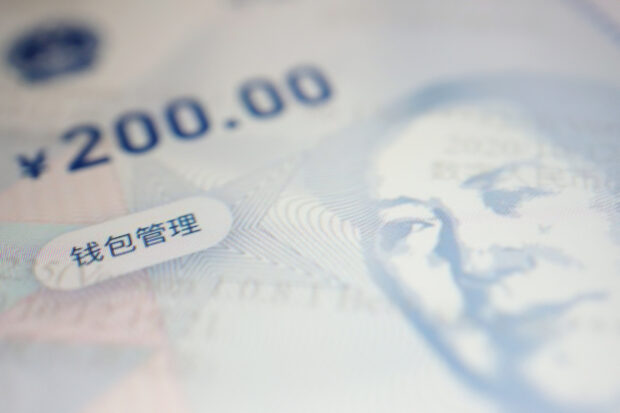China’s official app for digital yuan is seen in this illustration picture taken Oct 16, 2020. REUTERS/Florence Lo/Illustration/File photo
SHANGHAI – China’s short-term money rates spiked on Tuesday, the last trading day of the month, driven up by higher seasonal demand for cash, while markets continue to expect the central bank to inject more liquidity in coming months to shore up a fragile economic recovery.
The benchmark overnight repo traded in the interbank market jumped as much as 255 basis points to 4 percent in morning deals, the loftiest level since Feb. 28. It last traded at 1.8658 percent on Tuesday afternoon.
Higher borrowing costs come at a time when month-end demand for cash increased, as financial institutions are required to keep cash positions high to fulfil various regulatory checks and administrative requirements, leaving many banks reluctant to lend to their peers.
“The liquidity tightness caught me off the guard, the price suddenly shot up,” said a trader at a brokerage.
The People’s Bank of China (PBOC) injected a net 19 billion yuan ($2.60 billion) through open market operations on Tuesday, but some bond traders said the amount was too small as a vast majority of banks have become more cautious in lending towards the month-end.
However, in the derivatives market, investors do not expect such liquidity tensions to persist. They are betting on higher liquidity injections and possible rate cuts to cope with the newly approved 1 trillion yuan ($136.67 billion) of sovereign bond sales.
READ: China’s new bonds to help economic recovery, official says
The one-year interest rate swaps, which show investor expectations of future yields, have fallen 7 basis points this week to 2.02 percent since China announced the new debt issuance last week to support the rebuilding of disaster-hit areas.
“Repo-IRS traded on the soft side this morning, as China PMIs printed lower than expected, while the market continues to hold expectations for some liquidity injections to buffer the impact of higher bond supply,” said Frances Cheung, rates strategist at OCBC Bank.
“We see a heightened chance of a reserve requirement ratio (RRR) cut which would be helpful as a 25-basis-point cut can release liquidity to cover a large part of the additional bond issuances.”
Sources told Reuters that China’s issuance of such sovereign bonds will not change the schedule of the central government’s bond issuance during the fourth quarter.
As China’s government speeds up spending plans to strengthen an economic recovery that has sputtered this year, investors are betting the central bank will help out by easing monetary policy further.
READ: Stimulus or bust: Investors staying out of China until the spending starts
Ming Ming, chief economist at Citic Securities, expects repo rates to be scaled back in November as the central bank is likely to maintain a loosening bias in its monetary policy stance.
“Chances of a RRR cut or excess liquidity injection through medium-term lending facility (MLF) rollover this year remain possible,” Ming said.
($1 = 7.3167 Chinese yuan)
Denial of responsibility! Samachar Central is an automatic aggregator of Global media. In each content, the hyperlink to the primary source is specified. All trademarks belong to their rightful owners, and all materials to their authors. For any complaint, please reach us at – [email protected]. We will take necessary action within 24 hours.

Omprakash Tiwary is a business writer who delves into the intricacies of the corporate world. With a focus on finance and economic landscape. He offers readers valuable insights into market trends, entrepreneurship, and economic developments.


